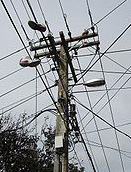
Fast, affordable Internet access for all.

The fifth anniversary of the announcement of the KentuckyWired project is approaching later this year. As voters start to assess their candidates’ job performance, the unfinished and over budget middle mile public-private partnership (P3) has become an albatross that incumbents aren’t able to easily cast off. When we last discussed the project in 2017, we shared our observations and misgivings. Not much has changed, except some of our concerns have played out and the project has become troubled by new problems.
In Case You’re Just Arriving to the Party…
The statewide, massive middle mile project officially began when Kentucky announced in late 2014 that they would build a fiber optic network in order to bring better connectivity to rural areas. They planned to find a private sector partner and sought bids. In the fall of 2015, Australian firm Macquarie won the contract for what soon became an even larger endeavor — a fiber optic network that would enter every county in the state at a minimum of one location. The network would consist of approximately 3,200 miles of fiber and connect about 1,000 public facilities. At the time the project was developed, the state estimated that deployment would cost approximately $300 million.
With early bipartisan support, the state allocated $30 million from their budget, which they expected to combine with $23.5 million in federal grants. When the Kentucky Economic Development Finance Authority issued $232 million in tax-exempt revenue bonds and $58 million in taxable revenue bonds to complete financing, Bond Buyer named the issue the “Deal of the Year” for 2015. Macquarie’s timeline estimated an optimistic one-year completion for the entire statewide project.
 Macquarie Capital, as the entity managing the project, included in the agreement with the state a requirement that they and their partners, including Black & Veatch from Kansas and Ledcor of Canada, would build, operate, and maintain the network for 30 years. During the course of those three decades, the state would pay them approximately $1.2 billion and when the term was over, Kentucky would own the infrastructure free and clear. During the contract period, Kentucky would make “availability payments” which would increase over the course of the contract, regardless of the status of construction. State facilities would no longer need to lease lines or pay AT&T for services because KentuckyWired would replace AT&T at state facilities. The shift would eliminate the $27 million per year telecommunications fees that Kentucky paid to AT&T.
Macquarie Capital, as the entity managing the project, included in the agreement with the state a requirement that they and their partners, including Black & Veatch from Kansas and Ledcor of Canada, would build, operate, and maintain the network for 30 years. During the course of those three decades, the state would pay them approximately $1.2 billion and when the term was over, Kentucky would own the infrastructure free and clear. During the contract period, Kentucky would make “availability payments” which would increase over the course of the contract, regardless of the status of construction. State facilities would no longer need to lease lines or pay AT&T for services because KentuckyWired would replace AT&T at state facilities. The shift would eliminate the $27 million per year telecommunications fees that Kentucky paid to AT&T.
Kentucky planned to first connect 173 school districts and use federal E-rate funding to contribute to availability payments. They anticipated that schools would be connected to the network within the first year and the E-rate dollars would be made available right away. In the past, E-rate funds had been used to pay AT&T for services through a long-term arrangement, and when the state tried to solicit new bids expecting KentuckyWired to bid on the contract, the company was ready to sue. E-rate regulations disqualified the project from using the funds as intended in 2015 and the state was stuck in a bind: facing pressure from the telecommunications giant and caught owing availability payments while their anticipated stream of funding was now cut off. Eventually, the state chose to continue their contract with AT&T. The events lead to a gap in funding to the tune of $11 - 13 million annually. It foreshadowed other problems that would plague their celebrated project.
According to a story developed by ProPublic and the Louisville Courier Journal, State Auditor Mike Harmon had looked into the shortfall as part of the 2018 report on the project. Harmon’s team found that the Commissioner of Education in 2015 informed Finance and Administration Cabinet Secretary Lori Flanery along with former cabinet secretary Mary Lassiter that the project would not qualify for the E-rate funds but those warnings were ignored.
Obtaining easements from private property owners added to the delay. While the KentuckyWired project is supposed to be working with municipal networks in the state, it’s natural to expect some hesitation from local municipal network officials. For example, Glasgow’s Billy Ray expressed concern about a new entrant with the financial backing of the state competing in their service area. “We have some concerns about what is their ultimate goal,” he said. It doesn’t appear that KCNA or Macquarie did much to ease concerns from local officials in order to move the project along.
More Shifting of the Risk
As we covered in our 2017 article, the state established the Kentucky Communications Network Authority (KCNA) to operate and maintain the infrastructure. As per the contract between the state and Macquarie, the KCNA has had the responsibility of obtaining pole attachment agreements. As is often the case, large incumbent ISPs like AT&T can delay the launch of a new entrant’s project by prolonging negotiations for the agreements. The KCNA and Macquarie also grossly underestimated the number of poles that AT&T owned in the state, which greatly complicated their ability to obtain pole attachment agreements.
 As part of the partnership agreement, Macquarie would also have the ability to lease capacity to ISPs and share the resulting revenue with the state. Macquarie estimated that the firm could garner as much as $600 million over the 30-year term. All this delay cut into the revenue that Macquarie had expected to obtain from the project.
As part of the partnership agreement, Macquarie would also have the ability to lease capacity to ISPs and share the resulting revenue with the state. Macquarie estimated that the firm could garner as much as $600 million over the 30-year term. All this delay cut into the revenue that Macquarie had expected to obtain from the project.
ProPublica and the Courier looked into 2015 negotiations between Kentucky and Macquarie; the results indicate high risk for the state but not for its partner. In addition to the availability payments, made regardless of whether the network is up and running, Kentucky agreed to pay the firm if the state was not able to secure pole access in less than a month. Obtaining the agreements took more than seven months and all the while the state’s obligation to pay “penalties” to Macquarie due to the pole attachment debacle in addition to availability payments to partners continued to pile up. In February 2019, Macquarie and Kentucky negotiated a settlement that ended in a payout to the firm of $93 million.
The timeline of the project has been pushed back to a 2020 completion date.
Experts have gone on record describing the overly-ambitious construction schedule as “unrealistic” and “wildly aspirational.” Phillip Brown, who used to work for the KCNA but left to work for ISP Crown Castle told the Courier Journal that he believes the quixotic construction schedule resulted from an attempt to convince lawmakers and the public to back such a large project:
“What would the reaction to KentuckyWired have been if the state had said at the beginning it will take us until 2020 and it’s going to cost about $400 million?" Brown asked. "Well, maybe the state doesn’t do the project, but it also means that we don’t have those false expectations that were created by a schedule that wasn’t achievable."
The state made the mistake of letting its desired costs on paper dictate an ultimately impossible construction schedule, he said.
The Affect in Frankfort
 When it became clear that lack of access to E-rate funding created a 45 percent funding gap, and the state was still on the hook to Macquarie and others for availability payments, state lawmakers began to lose enthusiasm for KentyckyWired. There were calls to scale back the project to serve only the eastern area of the state. Governor Matt Bevin, who assumed office in December 2015, at one time supported reducing the scale of the project but has reversed course. In 2016, Bevin proclaimed that the state had solved the funding issue, but no one seems to know the details of how the administration planned to accomplish that feat.
When it became clear that lack of access to E-rate funding created a 45 percent funding gap, and the state was still on the hook to Macquarie and others for availability payments, state lawmakers began to lose enthusiasm for KentyckyWired. There were calls to scale back the project to serve only the eastern area of the state. Governor Matt Bevin, who assumed office in December 2015, at one time supported reducing the scale of the project but has reversed course. In 2016, Bevin proclaimed that the state had solved the funding issue, but no one seems to know the details of how the administration planned to accomplish that feat.
Besides the fact that the state would face off against Macquarie and its partners if the contract were broken, the long-term future of the project depends on the ability to reach urban areas beyond those in the east. Reducing fiber miles deployed needs to be balanced against loss of potential revenue.
Lawmakers have granted permission for KentuckyWired to borrow some, but not all, funding to help right the ship as it related to the Macquarie settlement. Legislators have kept a close eye on how much they’ll allow because it has the potential to negatively impact the entire state’s credit rating. There’s still talk of ending the project, but as 2020 approaches, most in the Bevin Administration continues to work to shore up support:
"We're on the cusp — the eve, literally — of this project being completed and starting to produce revenues, and we're having a discussion about terminating this project? It makes no sense, financial or otherwise," [KCNA Scott] Brinkman told state lawmakers. "It makes no sense."
Not everyone in the Bevin administration has been expressing support for the project, however, including the generously compensated Chief Technology Officer Charles Grindle. He’s made several public appearances and bruskly voiced negative feelings about any switch from AT&T to KentuckyWired for state facilities. While Grindle may be justified in his concern for an abrupt change in provider, his willingness to accept invitations to “exclusive conferences” where famous acts perform and his repeated praise about the virtues of AT&T as a “trusted partner” could cast a shadow on the motivation for his disdain for the project. Regardless, it exemplifies the tight hold large ISPs such as AT&T have on state government.
Almost There
Phillip Brown notes that some of the largest state entities, including the University of Kentucky and other educational institutions, are likely to have access to the network when the first of six rings is completed in the fall of 2019. By working with other Internet access companies in the state that have their own fiber, KentuckyWired has been able to cut some costs and reduce construction time.
 A few local communities, however, have given up on waiting for the project and some just aren’t close enough to the proposed route to think it will benefit their need for better connectivity. Lechter County is moving forward with their own project, and Hopkinsville is upgrading their system to fiber through their electric utility. Telephone and electric cooperatives in Kentucky continue to offer services and expand to more premises.
A few local communities, however, have given up on waiting for the project and some just aren’t close enough to the proposed route to think it will benefit their need for better connectivity. Lechter County is moving forward with their own project, and Hopkinsville is upgrading their system to fiber through their electric utility. Telephone and electric cooperatives in Kentucky continue to offer services and expand to more premises.
Political Fall-out
To no one’s surprise, challengers who want Bevin’s job are using the problems surrounding KentuckyWired as a way to both lambast his performance and make their own promises for broadband across the state. Those who support the project claim Bevin, who inherited the project from former Governor Beshear, has not done enough to keep it on schedule. In the other camp are those who say he should have ended KentuckyWired long ago.
Politicians running for Governor who believe the project should be scrapped argue that funds should be distributed on a local level, some to large ISPs and some to rural co-ops. A few point to the success of rural cooperatives as a promising solution to the state's rural broadband problem. Others believe the only way to proceed is to move forward with the project and remain committed to a public-private partnership model.
What Is A True P3? No.
We’ve articulated misgivings about the statewide approach of KentuckyWired in the past and those concerns remain, although now we see the damaging results.
First, the state's P3 put too much risk the shoulders of Kentucky and too much gain in the lap of Macquarie. One wonders if the state was too rushed in developing the schedule and contract. We wonder if attorneys for the state consulted technical experts who had deployed fiber optic networks in territories where AT&T operates. Did they listen to warnings about what to expect from the incumbent?
 As we covered in our 2016 report, public-private partnerships have potential but need to include shared risk and shared reward. Often a public entity enters negotiations considering themselves at a disadvantage, which is typically inaccurate. Clearly all the risk in Kentucky fell on the state; Macquarie and their partners gain financially regardless of whether or not they deploy the KentuckyWired network. The firm sought a guarantee-type arrangement at one time when they considered investing in Utah’s UTOPIA network around the same time they began negotiating with Kentucky. The UTOPIA deal fell through. We’ve had our doubts about Macquarie from the beginning.
As we covered in our 2016 report, public-private partnerships have potential but need to include shared risk and shared reward. Often a public entity enters negotiations considering themselves at a disadvantage, which is typically inaccurate. Clearly all the risk in Kentucky fell on the state; Macquarie and their partners gain financially regardless of whether or not they deploy the KentuckyWired network. The firm sought a guarantee-type arrangement at one time when they considered investing in Utah’s UTOPIA network around the same time they began negotiating with Kentucky. The UTOPIA deal fell through. We’ve had our doubts about Macquarie from the beginning.
Few public-private partnerships don’t find their way on to our Community Networks Map because the shared risk, shared reward arrangements are few. In places like Westminster, Maryland, where both public entity and private sector ISP are motivated to invest in the network, the P3 has succeeded, earning accolades from experts, gaining subscribers, and expanding.
Going With the Preferred Local Option and Connecting Subscribers
Westminster’s P3 with ISP Ting is also successful because it is a local project that offers last mile connections. While the future of KentuckyWired is yet to be determined, middle mile publicly owned networks don’t have the track record that compares to last mile projects. Middle mile projects still require investment from ISPs that want to use the infrastructure, which may prevent smaller ISPs from participating because they don’t have the capital to develop the last reach of the project.
Local communities scattered across Kentucky have their own needs. We still believe that a statewide project operated and managed by a state entity is less likely to understand and respond to those needs as well as the people who live and work within those communities. When we wrote about the project in 2017, we noted that Kentucky was, at least, working to address the lack of broadband in rural areas. Since then, little has changed in areas where co-ops or municipalities are not making investments in broadband networks.
Tina Sparkman in Letcher County told the Courier Journal that she relies on satellite Internet access because it’s her only option. Her rates are high and she hits her bandwidth cap early in every billing cycle. Her college-age children don't visit as often as she'd like because they need access to the Internet to complete assignments. “We can’t wait 10 more years for Internet,” she says.
Until KentuckyWired is launched, we won't know if the project will help attract better broadband to rural areas. On a positive note, when or if Kentucky and their partner complete deploying fiber throughout their state, they will have resources in place for private sector providers who may be interested in offering 5G or fixed wireless services. Once again, Kentucky's agreement with Macquarie might hinder what the state can do with their own infrastructure for the remainder of the contract.
In 2017 we wrote:
Time, money, and politics will limit whether Kentucky stays steadfast and completes the project as planned, or decides to reassess the choices they've made so far. However they move forward, they've established some important lessons on scale, partnerships, and thoroughly preparing a sound plan. From our perspective, it has not done much to change our argument that large scale investments are best done at the local level and public-private partnerships are significantly riskier than many realize.
Things appeared difficult in 2017 and after five years of compounding problems, disagreements, and significant financial troubles, are still troubled. As state leaders and project officials keep their eye on a fall launch, Kentuckians such as Tina Sparkman are done waiting for the state and are acting locally. She's joined the Lechter County Broadband Board and the group recently applied for a grant as they pursue local solutions for better connectivity. Go, Tina, go.
Image of Kentucky landscape by David Mark from Pixabay.
